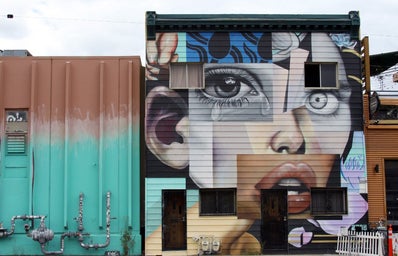“Do women have to be naked to get into the Met. Museum?” asked the Guerrilla Girls—an advocacy group of feminist artists—in 1989. The question was plastered onto bright yellow posters featuring a nude, reclining woman with her head obscured by a gorilla mask—classically worn by the anonymous group members. The posters were placed inside New York City buses to bring attention to the historical prominence of sexualized women as artistic subjects, showcased widely at the Met.
Today, the Guerrilla Girls’ artwork is being displayed in the Berkeley Art Museum and Pacific Film Archive (BAMPFA)’s exhibition, “New Time: Art and Feminisms in the 21st Century.” The exhibition, which features 77 artists and over 150 works, revolves around eight themes: “hysteria; the gaze; revisiting historical subjects through a feminist lens; the fragmented female body; gender fluidity; labor, domesticity, and activism; female anger; and feminist utopias,” according to the BAMPFA website. The museum hopes that “New Time” will illustrate the necessity of multifaceted, intersectional, and nuanced feminism today.
While each of the themes presented by the exhibition is fascinating in its own right, I am most interested in focusing on “the gaze.” For so long in the history of art — and, for that matter, the world — men have dominated the canvas. Thus, the vast majority of art depicting the female body was created by men, for men, and from a heteronormative “male gaze.” This perspective heavily depends on the sexualization and objectification of the female figure for a male audience’s viewing pleasure. A prominent historical example is Titian’s Venus of Urbino.
“New Time,” however, gives artists who are affected by patriarchal ideologies the opportunity to challenge, dismantle, and rewrite the heteronormative male gaze. Featured artist Zanele Muholi, for example, uses photographic portraiture to celebrate the sexual identities of transgender people in South Africa. As a South African LGTBQ+ activist herself, Muholi’s photographs, such as Eva Mofokeng I, Parktown, Johannesburg, provide transgender people with a safe space to express their sexuality.
Muholi’s photograph is just one example of the exhibit’s reclamation of “the gaze” through sexual liberation. In many ways, I am reminded of renowned feminist philosopher Judith Butler’s theories on the performativity of gender and the social construct of sex. Like gender, art is first analyzed based on its presumed purpose and outward appearance, and then interpreted by the larger world for a conclusive meaning or significance. This is what makes the union of art and gender in “New Time” so compelling.
“New Time: Art and Feminisms in the 21st Century” will be exhibited at BAMPFA through January 30, 2022.
If you would like to write for Her Campus Mount Holyoke, or if you have any questions or comments for us, please email hc.mtholyoke@hercampus.com.

